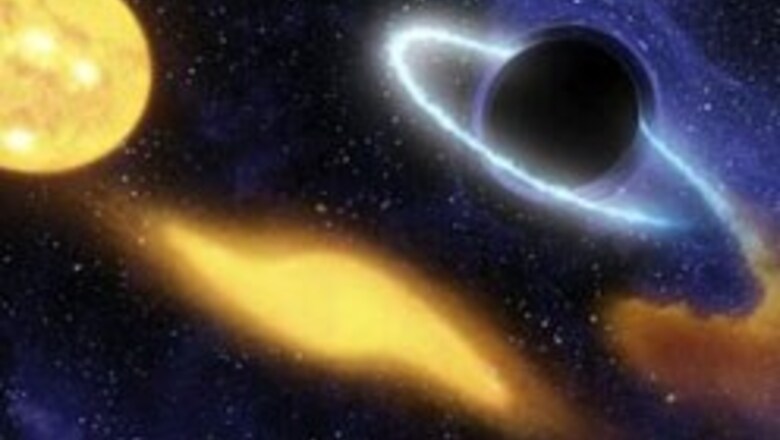
views
Washington: A giant black hole displaying horrifying table manners has been caught in the act of guzzling a star in a galaxy 4 billion light-years away, scientists using an orbiting NASA telescope said on Tuesday.
For the past two years, scientists have monitored the dramatic events, as the star, residing in a galaxy in the Bootes constellation, was ripped apart by the black hole.
Scientists used NASA's Galaxy Evolution Explorer, an orbiting telescope sensitive to two bands of ultraviolet wavelengths, to detect an ultraviolet flare coming from the center of a remote elliptical galaxy.
"This ultraviolet flare was from a star literally being ripped apart and swallowed by the black hole," Suvi Gezari of the California Institute of Technology in Pasadena and lead author of the paper describing the findings in Astrophysical Journal Letters, said in an interview.
"This is the first time that we've actually been able to monitor the flare of radiation from such an event in detail. Only once every 10,000 years will a star pass close enough to a (galaxy's) central black hole to be ripped apart and swallowed in this manner," Gezari said.
The scientists hope the findings will give them a better understanding of black holes, objects whose gravity is so powerful even light cannot escape.
It is believed that super-massive black holes are located at the core of every galaxy. For example, Gezari said, the Milky Way galaxy in which our solar system resides has a dormant super-massive black hole at its center.
Scientists said in this case the unfortunate star strayed a bit too close to the black hole deep inside the galaxy, and was mutilated by the force of its gravity.
They believe that parts of the star swirled around and then plunged into the black hole, which sent out the bright ultraviolet flare that the satellite detected.
Scientists continue to use the telescope to observe the ultraviolet light as it fades while the black hole snacks on the final table scraps from the devoured star.
"We looked at the galaxy in 2003 and there was no ultraviolet light coming from the galaxy at all," Gezari said. "And then in 2004, we suddenly saw this very bright source."
"The only way to explain such a luminous ultraviolet flare is if the black hole swallowed a star," Gezari said.
Caltech leads the Galaxy Evolution Explorer mission and is responsible for science operations and data analysis, while NASA's Jet Propulsion Laboratory manages the mission and built the instrument.
The scientists also used data from NASA's Chandra X-ray Observatory, the Canada France Hawaii Telescope in Hawaii and the Keck Telescope in Hawaii.




















Comments
0 comment